Travel Medical Insurance, Pre-Existing Conditions, & Type 1 Diabetes
Long-Term International Travel…With Type 1 Diabetes Or Other Pre-Existing Conditions
Everything changes when you get a life-altering diagnosis, including the complications of travel. Now, I am still fairly new to all of the ins and outs of long-term, international travel. I only changed my life and sold everything to be location independent and to travel like a nomad…just over two years ago. Then I got diagnosed with Type 1 diabetes barely a year after I sold it all…during a pandemic no less. Now what?
The game has changed, and I must adapt. Now I have to navigate the intricacies of “normal” daily life with Type 1 diabetes and also how to travel with diabetes. Add to that sorting all of the new prescription medications, insulins, needles, and other things that come with it.
Join the email list to stay in the loop on new releases!
This site participates in the Amazon Services LLC Associates Program and other affiliate programs and may earn from qualifying purchases. You’re never charged more, but it helps out little by little! Check out “Privacy” in the top menu if you need to know more!
But this isn’t just an article about how to travel with diabetes. This is an article about how to with travel with any life-changing diagnosis—or what insurance will call a pre-existing condition—and all of the things that are required. Yes, I have Type 1 diabetes, but a lot of the steps I’ll detail will be great starting points for anyone that wants to travel with an illness or diagnosis that requires constant upkeep.
Read along and please share this with anyone in your life that’s struggling to move forward with travel or truly experiencing life after diagnosis.
Note that I’m speaking from my own experience here. This process can be vastly different depending on insurance, diagnosis, state of residence, etc. But hopefully this gives you a place to start! FYI, I currently use a local plan with Blue Cross Blue Shield, so this process reflects what I went through with them with regard to meds. Could be different for you even with the same carrier. Also, there is a lot more to insurance than I can dive into here! (Done with disclaimers…maybe.)
READ NEXT: Gifts For Diabetic Travelers—Essential Travel Items & Unexpected Gifts
Medications, Medical Waivers, and Travel Medical Insurance with Pre-Existing Conditions
Combined with the medications for my super-awesome heart issue, I’m on three different medications “required” daily for the rest of my life. Add to that the basal and bolus insulin for my Type 1 diabetes. I also currently use a Freestyle Libre 2 continuous glucose monitor, so there are also bulky applicators for those needed for each change every two weeks.
Connect & Share This Article
For travel of a week or two, whether domestic or international, having enough of all of the above is pretty simple. I might not even need to worry about keeping insulin refrigerated if the pens are open and have plenty for me to get through the trip. But three months?
Three months of long-term international travel with insulin dependent Type 1 diabetes—or any serious medical condition—takes some serious planning and coordination both before and during travel.
Here are all of the steps I’ve taken over the past couple of weeks to attempt to get my ducks in a row.
What Is A Vacation Override? Getting Extra Medication For Long-Term Or International Travel.
First things first, there was a reality that my medication refills—or quantities on hand— were kind of all over the place. I do 90-day supplies normally, but I had a few weeks’ worth of a couple, six weeks of another, and two months of others. (Yes, the plan is to get all my meds on the same refill schedule. Baby steps…)
But because I am going to be gone more than 120 days from my home state—I’m actually leaving the state 3 weeks before my Portugal trip—I had to sort out having enough to make it through those four months. I had no idea where to start, so that’s when I simply started asking questions.
My awesome pharmacist told me that what I needed was a “vacation override” for my medications so that I could get my next refills early, which would get me through the long trip. Now, I won’t go into how complicated and messy this turned out to be for me. I’m hoping it’s smoother next time. My pharmacist said it has been quick and painless for most, but we’re guessing that because my conditions require a lot of medications, it simply got messy.
6 Steps For Getting A Vacation Override For Your Medications For Long Trips
- Make sure you actually have refills available on your medications. If you don’t, you could need to do something like get a physical before they will approve refills. Then you’ll likely have to go to the doc before requesting your vacation override from your primary medical insurance provider. (Raises hand slowly…)
- Get together all of your dates and do the math on how many days of medications and units/pens/pills you’ll need. If possible, round up or see if you can get plenty in case you decide to extend your trip. I was able to get 90-day refills for all of mine which would cover me for almost an additional month and a half if I wanted to extend. For insulin, there’s also always the possibility that a pen goes bad, so having an extra backup or two is required.
- Make sure you list specific medications and the exact dosages you require. Also make sure to have your pharmacy address and phone information ready. When you talk to your insurance, make double sure they have these things correct before you get off the phone! (Smacks head since they missed a whole medication that I know we discussed, making me go through this all again…)
- Now call your primary health insurance customer service and tell them you need to request a vacation override. Let them know you’ll be traveling for an extended amount of time. Mine didn’t ask many questions other than how long I would be traveling; essentially how much I needed. Rumor has it you can do this twice a year, but I didn’t ask specifically.
- Get approved…hopefully. Then they’ll send the order to your pharmacy for you to pick up. Note that my insurance wanted this done extremely quickly. They sent the request immediately and told me I had to pick up my orders from the pharmacy within 48 hours or the order would be retracted. And my pharmacy almost never has my sensors in stock, so I got lucky this time.
- Move on to all of the other things you need to do…
READ NEXT: Diabetes Symptoms For Noobs – My Type 1 Diabetes Symptoms & Diagnosis
Gifts For Diabetic Travelers—Essential Travel Items & Unexpected Gifts
PROTIP: Know If Your Trip Spans Beyond Your Current Primary Insurance Plan’s Effective Dates
I spent literally hours on the phone, with supervisors involved, because they couldn’t figure out why things weren’t going through. Turns out my trip dates extended through the first of the year—when my current year’s health insurance policy expired and I would be on a new one.
This mucked up all the bits. They then simply backed up the end date a few days to make it Dec 31 and Bob’s your uncle—all was groovy.

Travel Medical Insurance…With Pre-Existing Conditions…For Diabetics And Other Diagnoses
In my opinion, getting travel medical insurance is an absolute necessity if you’re traveling internationally. Your primary insurance likely only covers you around where you live, and you can be “out of network” with even only a short domestic trip. So when you travel internationally, the chances are your primary insurance won’t cover much. Travel medical insurance is a very important secondary insurance to have that covers you internationally.
And travel medical insurance is smart to have regardless of whether you have a pre-existing condition or whether you plan to do anything you might consider adventurous during your travels. Both for long-term travel or short trips. I’ve heard too many horror stories and had close friends deal with major unforeseen issues.
Embolisms while simply walking across a street, broken ankles on cobblestones, and malaria and more can just happen. I’ve also witnessed hostel mates fall from one story to the next, resulting in a bloody mess of broken bones below, followed by crazy hospital shenanigans. No bueno. (More on that here…subscribe!)
Travel medical insurance is extremely inexpensive compared to a massive medical bill. You’ll also have someone to call to help you navigate any medical issues you have. They can tell you where to go and who to see at your destination. And any hospital is likely to give better care when they know they’ll get paid, so there’s that.
With that said, travel medical insurance providers do make it pretty tricky for those of us with pre-existing conditions. But fear not, there are options. That said, if you haven’t gotten comfortable digging into the details of insurance yet, this is a good time to start. Read the policy and exclusions and fine print before you purchase a plan, and make some phone calls and ask questions before you buy, like I did.
Important Clarification:
Travel Insurance can just cover travel medical issues. Travel insurance can also cover many other things… often called comprehensive insurance…like luggage, delays, etc. We are only talking specifically about travel medical insurance here and not any of those other add-ons!
What Is A Look-Back Period? And What Is A Pre-Existing Condition Waiver?
Before we get into things, you need to understand the lingo you’ll see now that you’re looking at getting a pre-existing condition covered with your travel medical insurance.
What is a Look-Back Period?
A look-back period is the amount of time before the date of your claim/incident that a travel medical insurance provider will “look back” to see if your pre-existing condition was under control. If they see red flags or can prove that it wasn’t, they could deny your claim. In order to approve your claim, you must be able to prove that your condition was “stable” during the look-back period.
Look-back periods are typically between 60-and 180 days and should be clearly stated when buying a policy. Obviously, if your travel medical insurance claim has nothing to do with your pre-existing condition, this shouldn’t be an issue.
READ NEXT: Books for Inspiration, Motivation, & Generally Slaying it at Adulting
What is a Pre-Existing Condition Waiver?
This is the “proof” you’re looking for to…hopefully…ensure that when the travel medical insurance company looks back, they have no reason to deny your claim. Specifically, this is proof “you are medically able to travel when your travel insurance policy is purchased” or that your “pre-existing condition is stable within the look-back period.” Some plans (like Travel Guard) fairly clearly state their requirements for getting a pre-existing condition waiver, whereas others bury it deeper in the details.
The policy I bought through Insure My Trip stated very clearly that it covered pre-existing conditions (with a look-back period), but still called and confirmed that I didn’t need a waiver. Some providers or policies that don’t state that they cover pre-existing conditions could still cover them, but you’ll want to make sure to appease them with whatever form or requirements of a pre-existing condition waiver or proof they need upfront. Other providers state right up front that they don’t cover pre-existing conditions. Guess we’ll take our business elsewhere!
Regardless of whether my plan asked for a waiver, I wanted some backup just in case. I went ahead and got a letter from all of my doctors—regardless of whether I needed it—stating very specifically that my pre-existing conditions were stable and that I was medically fit to travel. Those are signed by my doctors and I’ll keep them as a backup just in case I need them for a claim.
My backup plans even have backup plans, yo.
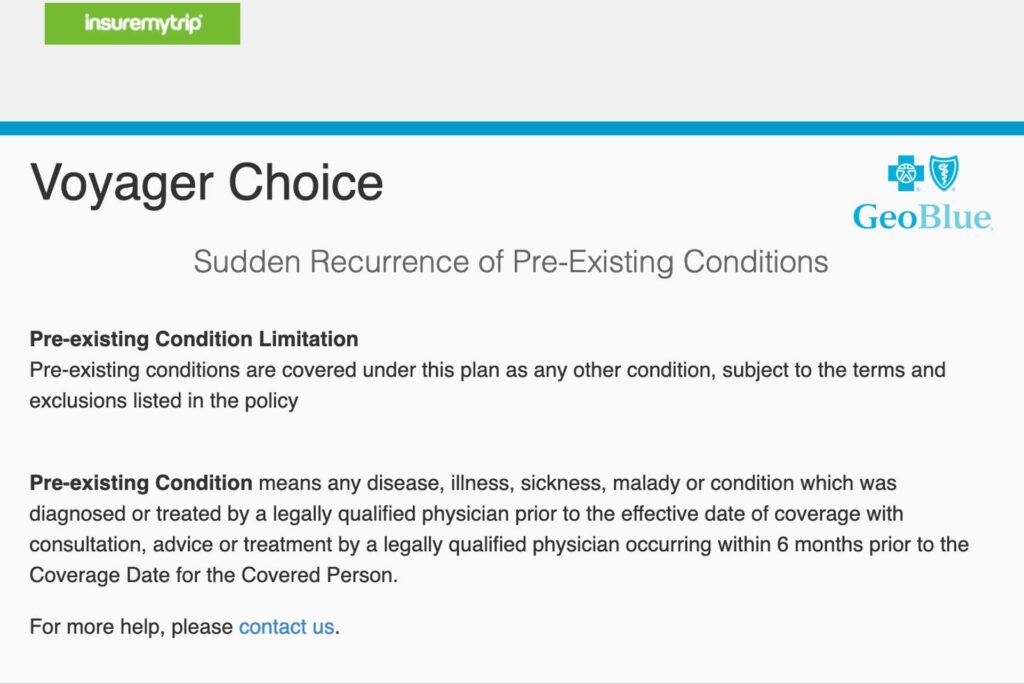
7 Steps For Getting Travel Medical Insurance With…Or Without…A Pre-Existing Condition
- Research and compare travel medical insurance. I highly suggest starting where I do, with Insure My Trip. They are to travel insurance what Orbitz is to flights and accommodations, or Hostelworld is with pulling hostel options worldwide. They only work with travel insurance carriers that meet their high standards, and they work as an advocate in your favor if you ever need to make a claim. They claim that “Over ninety percent of our claims advocacy customers were satisfied with the outcome.” I don’t want to ever need to use my insurance, but if I do it will be nice to have someone in my corner to work as a go-between with the insurance policy provider if needed.
- Beyond the many companies and travel insurance policy options Insure My Trip will show you, do your due diligence and compare some others. Look at World Nomads, SafetyWing, Travel Guard, TravelEx, and others in the industry. I’ve found that only a few of them state that they cover pre-existing conditions at all, but a couple do with a waiver. So sorting through the options Insure My Trip breaks down for you is still the easiest place to start.
- Make sure the plan you’re looking at states that it covers pre-existing conditions. Find the look-back period and confirm whether you need a pre-existing condition waiver or not.
- Narrow down to a couple of travel medical insurance plans that seem to look good to you. Then download a sample policy and read the details. There is usually a download link somewhere in the quote.
- Make a list of all of the questions you have up to this point about waivers, look-back periods, how to file a claim, when you should purchase your policy, etc.
- Make a call to an Insure My Trip rep and ask all the questions you have. Then call whatever provider/plan you’re looking at and ask them the same questions. If you’re getting different answers, ask again until you get clarity.
- When you’re as confident as possible in the travel medical insurance provider, policy, and all of the answers you’ve received, go ahead and purchase a plan. I checked, and the policy costs were identical regardless of whether purchased it through Insure My Trip or directly through the insurance provider. Feel free to do the same and purchase through whichever floats your boat. But if you want the advocacy go-between in case you need to make a claim, make sure you get the policy through Insure My Trip.
READ NEXT: I Just Got Diagnosed With Diabetes And I’m FREAKING OUT!
Gifts For Diabetic Travelers—Essential Travel Items & Unexpected
Proving You’re “Fit For Travel,” And Coordinating With Your Doctors
I want to interject here very specifically again how I approached all of my doctors (three to be exact…) and got letters and details for travel. I suggest you do this with plenty of lead time since, if the letter isn’t to your liking, you’ll need to go back and have them do it again. (Raises hand again…not my fault.)
Again, I didn’t technically need this, since the policy I got didn’t need a pre-existing condition waiver. This was just another layer of confidence for me to have. But I’m guessing this process would work for the waiver, depending on the requirements of certain travel medical insurance providers.
- Contact your doctor (or doctors if multiple) via your health portal or email, since being very specific is easiest if you can write/type it out. Feel free to let them know that this is so that you can obtain travel medical insurance and/or use it when traveling internationally through TSA or at border crossings.
- Request that your doctor supplies a signed letter…on letterhead…that states minimally: “[Your name] is medically fit for travel and their [insert pre-existing condition here] has been well maintained.
- Ask them to include a specific list of medications you’ll be traveling with, down to dosages if possible. Also, ask them to put in the letter that they are important to your well-being and should be allowed to travel with you—on your person—at all times.
- Make sure they sign it and include contact information!
- Ask them to keep this letter template on file so that when you travel again in the future, all they need to do is update any medications, print, and sign. (They will appreciate this, so maybe mention that you want to save them trouble down the road, along with your utmost thanks for their help!)
- Ask them to either mail it to you or tell them you’ll pick it up. I suggest picking it up if at all possible since then you can really nail down a time frame.
- Minimally, keep these with you when traveling, and make a copy to keep in a safe place at home.
As I mentioned above, these are not only useful for insurance needs, but also for airports and border crossings, since you’ll likely be carrying more drugs than an extra from Breaking Bad.
Packing For 3 Months—Carry-On Only—With Type 1 Diabetes: Destination Portugal
You might be saying…“Wait. You’re Traveling For 3 Months Carry-On Only…with all of your diabetes meds and gear!?” Yep. This is a pretty ambitious experiment, but hey, that’s what I’m here for! Once I started traveling carry-on only, travel got so much easier. I’m not gonna give that up unless I exhaust all my options!
This is how I travel, so learn from me. But even if you travel with checked luggage, you’ll still find some serious space savers and packing tips here.
Do A Test Packing Experiment To Make Sure You Have Your Sh*t Straight
I’m a month out from my trip and I’ve already done this. I literally packed everything, including all of my Type 1 diabetes medications, continuous glucose monitor sensors, insulin, lancets, strips, Glucagon, glucose tablets, etc., to make sure it all fit. Oh, and I also had to fit a 15“ MacBook Pro, a 10” iPad, Sony Mirrorless with 2 lenses, GoPro Max, Gorilla Pod, and selfie stick/tripod. Along with all the cords and batteries that go with them.
All of this packs into a 35-liter Tortuga carry-on backpack and my Pacsafe Angry Lane backpack that I use for my personal item.
Short or Long-Term Travel With Diabetes – Packing Medications While Saving Space
This was the biggest space-saver I made, considering I have over half a square foot of prescriptions and paraphernalia for my Type 1 diabetes and other ailments. I literally counted out the exact amount of meds and pills I needed for the trip, then added a bit for safekeeping or a possible trip extension. Same for my insulins. Here’s what I did:
- Kept all of the prescription printouts from the pharmacy which detail the different prescriptions, dosages, and my information. These correspond with the letters from my docs which state all of my prescriptions.
- Took the pills for each medication and put them in separate small plastic zipper baggies along with their specific prescription printout. I also labeled the outside of the bag for quick reference. Pill bottles are a huge space-waster!
- Removed all of my Libre 2 sensors/applicators from the boxes and put 3 sets each in quart plastic bags along with their prescription printouts. NOTE that these come in pairs that need to be used together! So I may mark them to make sure I don’t mix them up.
- I use these handy-dandy Frio cloth coolers to keep my unopened insulin pens cold during flights and travel. They keep things cool up to 48 hours and they are reusable.
- My daily use stuff lives in this case that has little ice packs if needed. I don’t normally need to use the ice packs, but this holds all my stuff nicely and I haven’t found a better one yet. (This one’s a little boring…needs some flare. Any suggestions?)
- Keep all of these things easily accessible when you’re traveling through security and customs along with all of the documentation we’ve talked about for when you get screened!
PROTIP: There may be trips where I’ll leave the Libre 2 and sensors at home and just do finger pricks and manual glucose checks. That will be dependent on the country and whether I feel it would be worth the hassle and space to pack them. Consider approaching these decisions on an as-needed basis regardless of what brand continuous glucose monitor you use…if you use any at all!
Travel With Type 1 Diabetes – Keep A Translated Explanation Of Your Condition And Travel Plans, Etc.
TSA in United States airports has specifically stated luggage allowances for diabetics. Those are backed up and detailed here by the American Diabetes Association. But traveling through airport security, customs, and immigration in other countries is going to vary depending on the country. I’ll be carrying a bulleted list of explanations of all of these types of details both in English and in any language spoken in the countries I’ll visit. This should help me explain my situation when questioned, whether I understand what I’m being asked or not.
I mean, I’m pretty sure any questions I’ll get will be with regards to whether I’m a drug mule or not. Just sayin’.
- I have [insert pre-existing condition(s) here] and these are my prescribed medications and letters from my doctors explaining my condition(s).
- My insulin must stay cold at all times so I am carrying it in these insulin coolers.
- I put my pills in bags with my prescription slips to save space since I travel carry-on only. (Here’s a quick video about why I fly carry-on only now, among other less expensive reasons…)
- I’m traveling within [insert country/countries here] for [insert amount of days here] and have a return ticket leaving from [insert return flight origination city here].
- I will leave the Schengen Zone in 88 days. (Specific to me because of the countries I’m visiting and the amount of time you’re allowed to stay there within a rolling window.)
Bullet-point minimally these details out in English and the language or languages you’ll experience in airports and at borders where you travel. Again, this is just another layer of protection for you to deal with any hurdles or roadblocks you could encounter while traveling internationally. And when you travel through airports and at borders, give yourself even more time than you typically would.
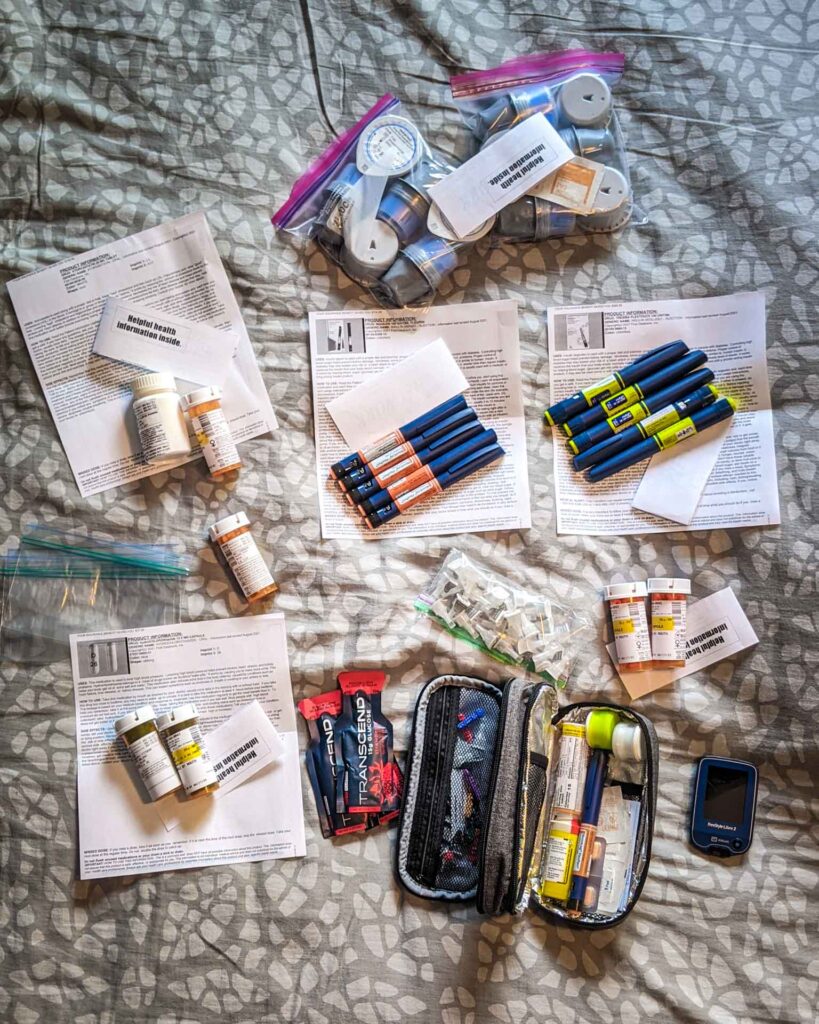
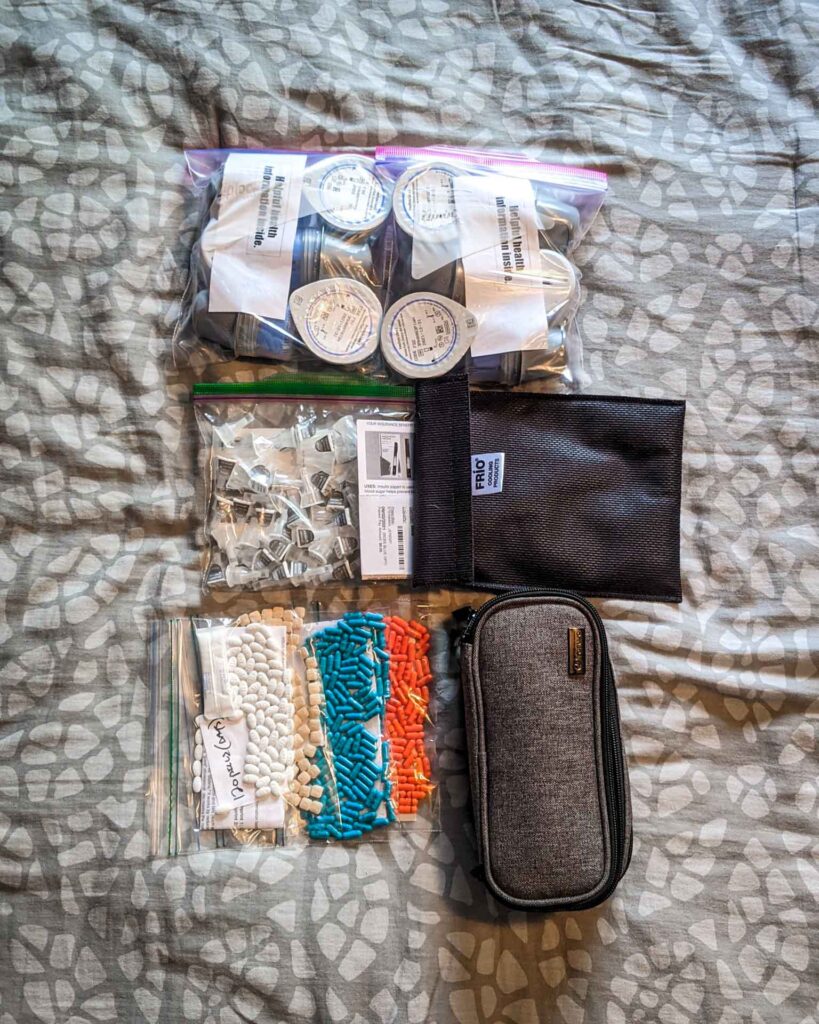
My Homework While I Travel In Portugal: Learn About The Cost Of Diabetes Supplies And What Access I Might Have For Future Trips…So I Don’t Have To Pack As Much!
The sad reality is that the cost of insulin in the United States is the highest in the world. Simple searches on these here interwebs will show you the comparisons in costs in different countries around the world. Many of those costs, while appearing low, also likely take into consideration being a citizen of that country and programs that in turn benefit those citizens.
The goal during my long trip through Portugal is to ask a lot of questions at pharmacies. I want to understand my options and exactly what medications, insulin, and durable medical supplies I might be able to access while in Portugal if I need them. Do I have to get a prescription? Are my medications even called the same name? Which insulins are available to me? Needle tips? Sensors? Yep, all the questions.
I’ll treat this as a fact-finding mission, and the more I can find out the better. My hope is that for future trips I might feel comfortable packing less if I know I can get certain meds abroad…and hopefully cheaper meds.
But again, this will be a work in progress for trips to every new country I go to. Yes, I can find some of this information through searches, but I’m going to be there, so I might as well do the work!
READ NEXT: EXPLORE PORTUGAL! Porto Travel Guide Sintra Travel Guide Guimaraes Travel Guide Aveiro Travel Guide
Join the email list to stay in the loop on new releases!
Connect & Share This Article
Follow Along On YouTube And Instagram
If you’re still reading this, thank you! Hopefully you found something helpful! I would really appreciate it if you commented below, gave some of your own advice to me or others reading. And please share this with a friend or family member!
Then connect with me over on Instagram and follow along as I give this all a try! You can also subscribe on YouTube, since I talk about a lot of these logistics and how things are going along the way!
Happy Travels. Cheers!
Jason


About Jason Robinson
Jason is the author of “The Beginner Traveler’s Guide To Going Nomad,” as well as the voice behind the words and the eye behind the lens for The Nomad Experiment. “Planning to travel at some point” wasn’t actually getting the job done, so nearing 40 he decided to make it a priority, nomatter how scary that was. A few years later—through the pandemic and a type 1 diabetes diagnosis at age 42—now living a life of nomadic travel, he’s speaking out to encourage others of any age, or with any serious medical diagnosis, to live an unconventional life.
Join the email list to stay in the loop on new releases!
Travel Planning Tips
Figure out where you are going & how are you getting there…
I suggest using at least 2 to 3 different travel search sites. Start with Skyscanner or Orbitz or Booking …or whatever aggregator site you prefer. Then when you see what airlines to use, check their respective sites for better deals or rewards flights.
Figure out where you’re going to stay…
If you’re interested in hostels, search Hostelworld or Hostelling International. For longer-term or more private digs, look at Airbnb, VRBO, or you can look for hotel rooms in the links from the search engines listed above.
Get comprehensive travel insurance, or in the least, travel medical insurance if internationally…
Especially with Covid not going anywhere, get covered. Start with an insurance aggregator like Insure My Trip, or with SafetyWing, World Nomads, or another. Then decide what is important to you; trip cancellation, baggage coverage, medical, or all of the above. And get a yearly evacuation plan, since you’ll have to get home after your emergency!
Need more resources? Click here!



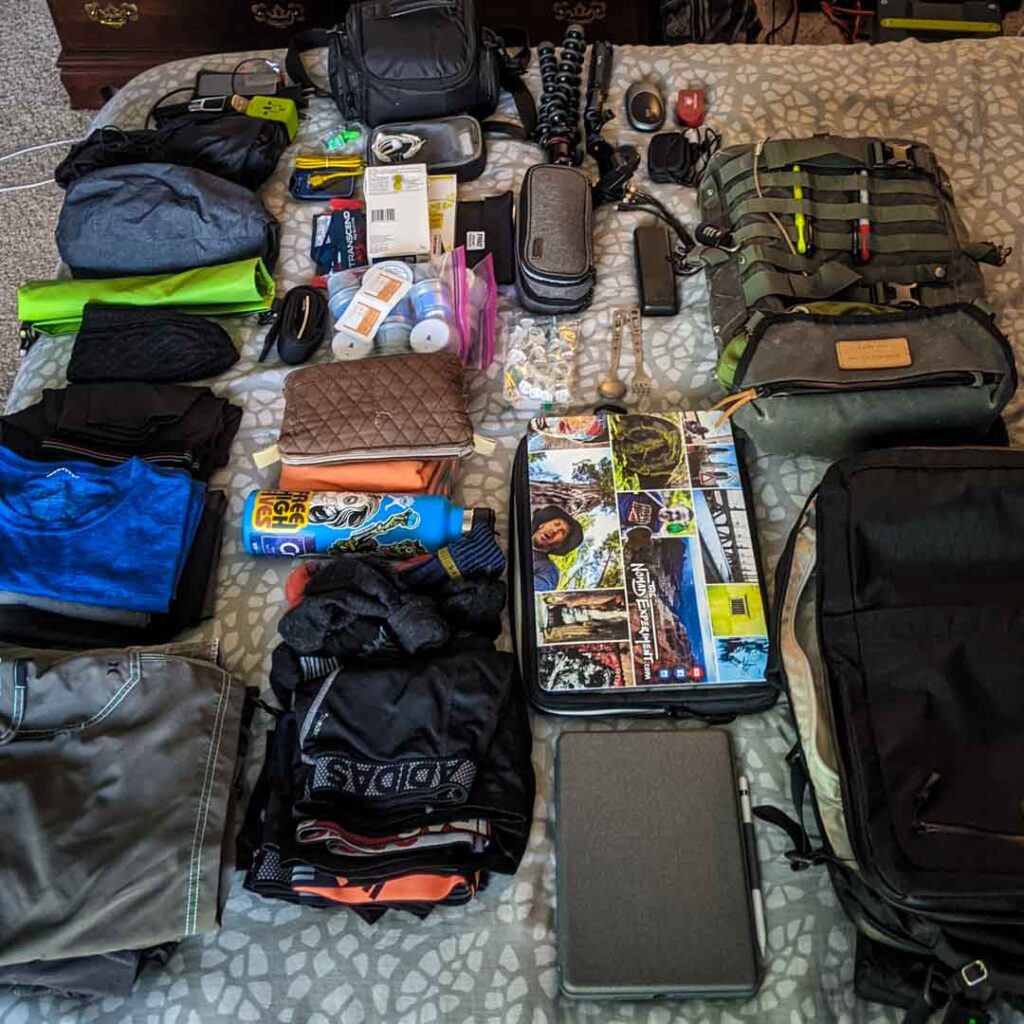
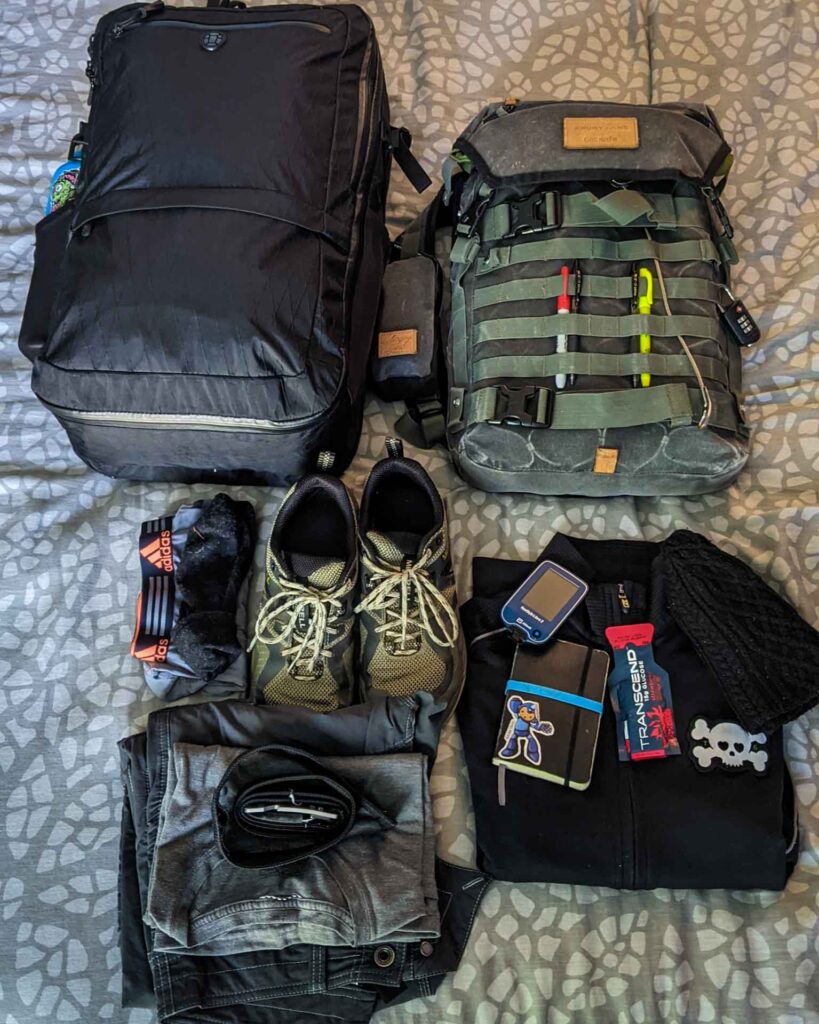
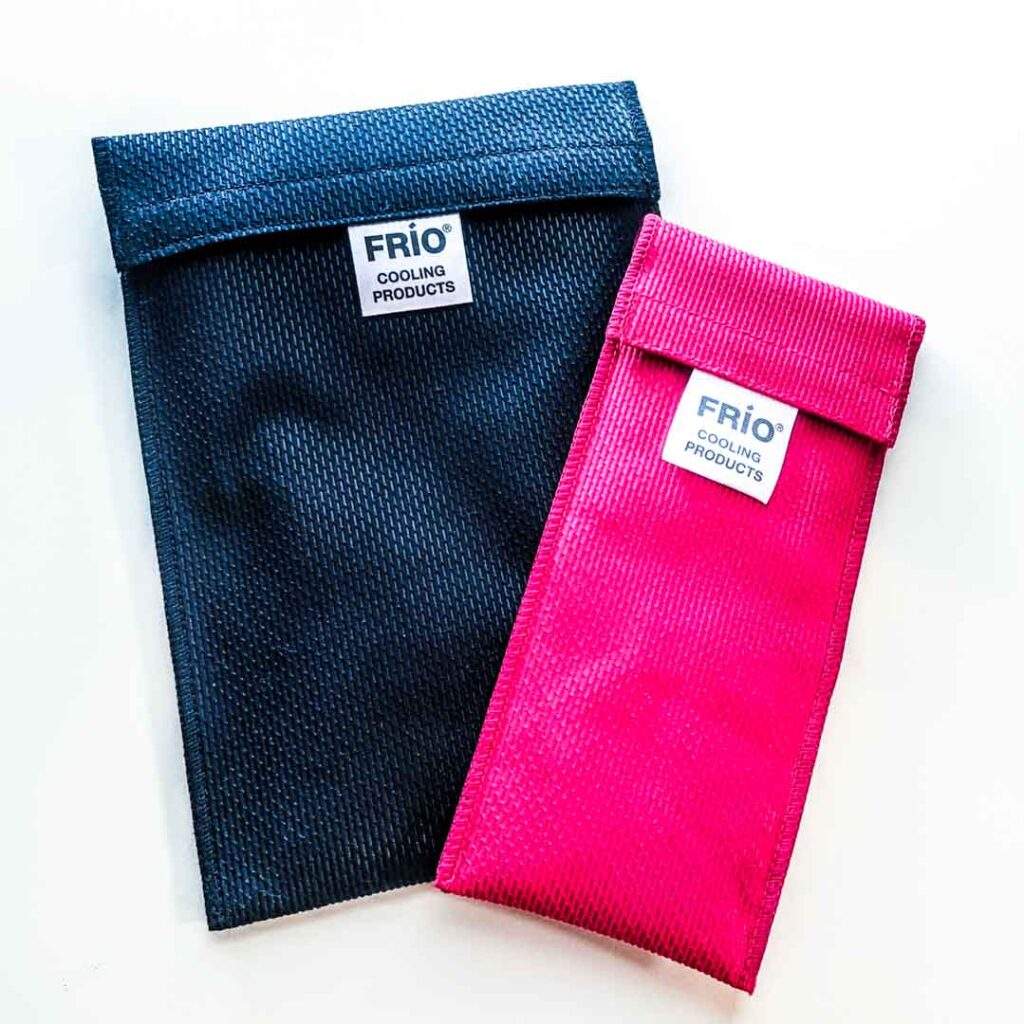
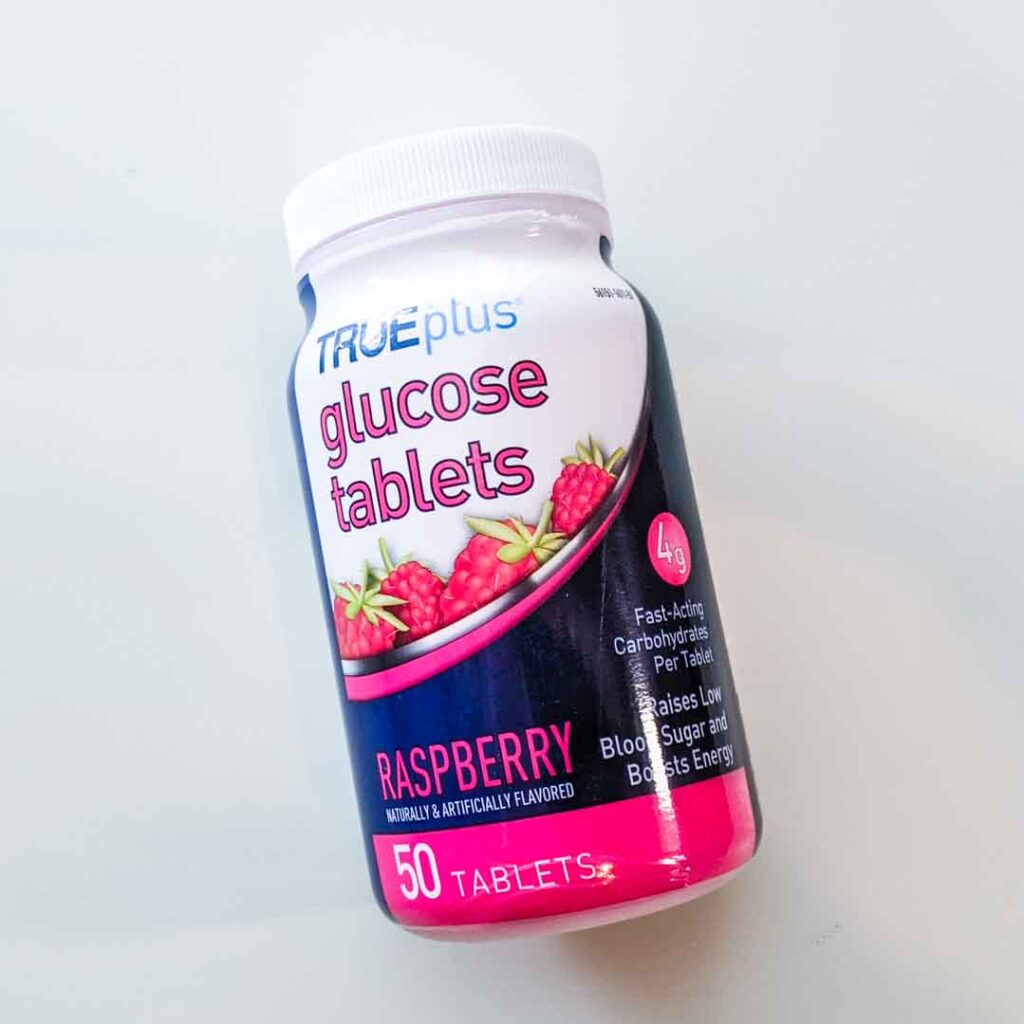
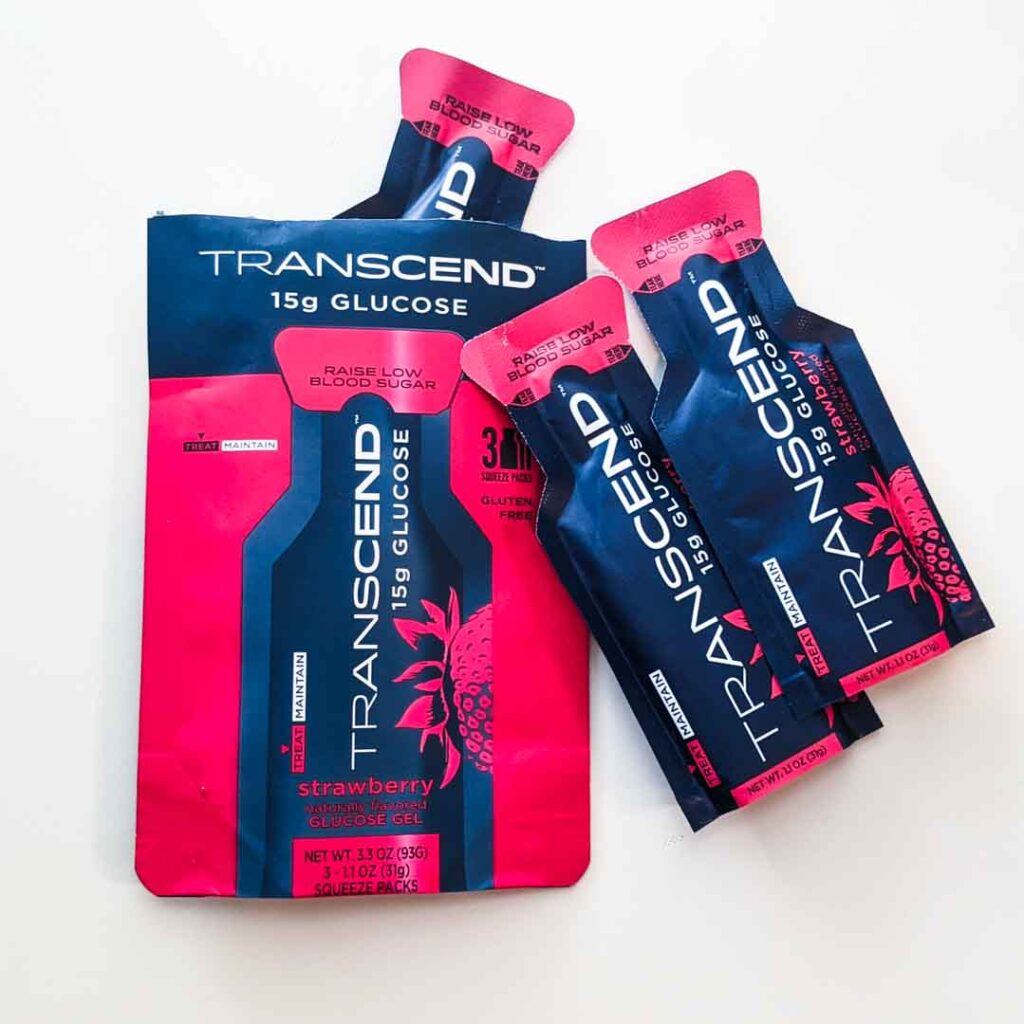


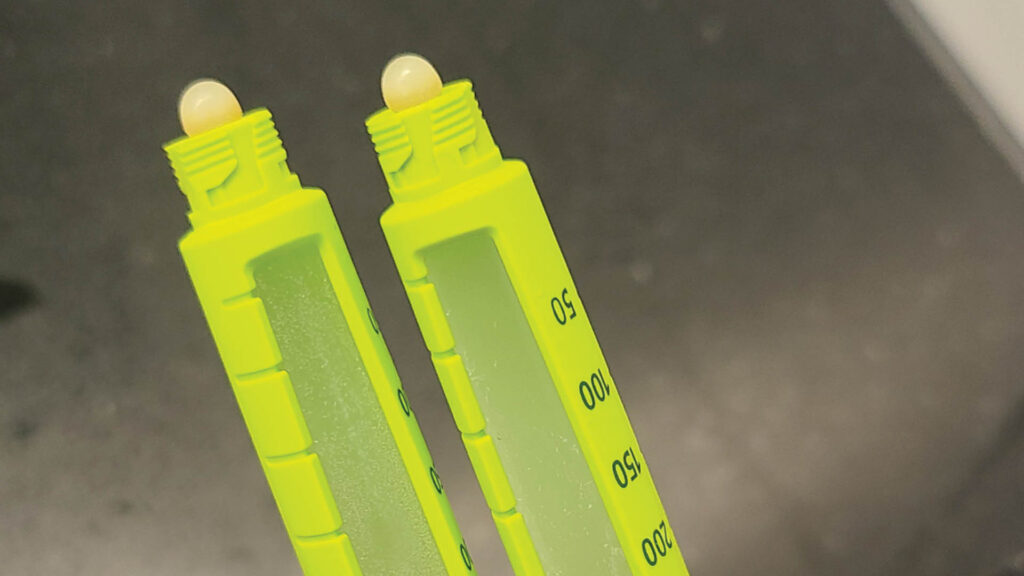

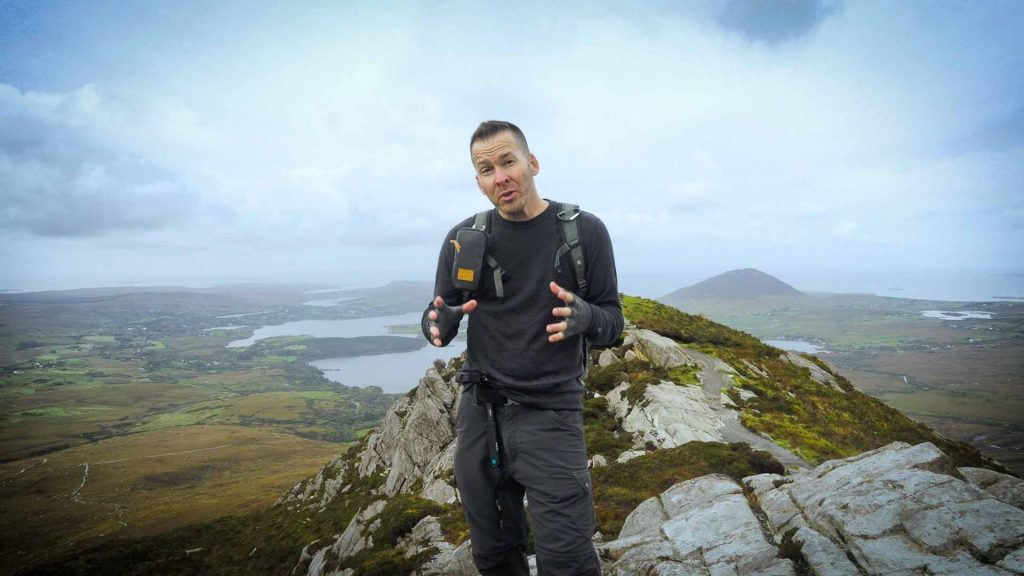
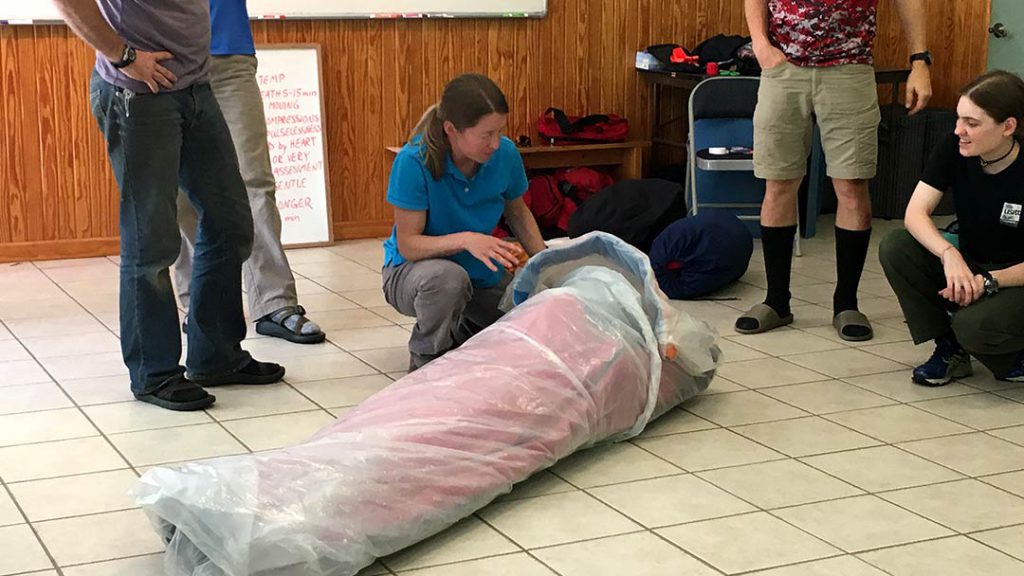
Hi Jason, I’m a Type 1 diabetic now living in Portugal since March of this year on a D7 visa. Now that I have a Portuguese health number, I pay $0 for insulin and about $10 for each Libre sensor. Even when I had private insurance here, I paid about $50 for each sensor and about $35 for a box of insulin pens. So much cheaper than in the U.S. I am in the Algarve, close to Portimao which is between Lagos and Albufeira, two very popular towns. I am 52 and was diagnosed when I was 30. I have traveled to many countries with my medication and sensors and have NEVER been asked to produce any proof of medication. Just recently I traveled back to the U.S. for the summer and took quite a lot of insulin and sensors with me and also got no questions. I don’t really think that a few months worth of medication would make them think you are a drug mule. Hope you have a great time in Portugal.
Haha. Thanks! I was joking about the drug mule part. 😉 Yes, at this point, it’s “better safe than sorry” for me on making sure I have documentation. I have checked at pharmacies in Porto, etc., and yes, around $45-60 euro a box. (2 pens got frozen on flight over.) Libres much more expensive, and sofar no pharmacy has had access to Dexcom G6, but I’ll keep asking. How did you get Portugese health number? Thanks for the reply! Helpful to hear from someone on the ground! Cheers.
Hi Jason, my doctor told me Dexcom is not available in Portugal. It seemed to me that the Libre was the only CGM choice as I told her Dexcom is what I was using back in the States. I looked up Dexcom’s international site and if I remember correctly, Dexcom is available in the UK, France and a few other EU countries. I suspect that the cost of Dexcom is currently not low enough for most countries to cover. My Portuguese lawyer filled out the paperwork for my health ID #, so not sure what the actual process is but there are some good Facebook forums that outline the process.
Hi! I’m thinking about moving to Germany (or Europe) but since I have Type 1 Diabetes, I’m having a hard time finding a company that will insure me. I ask because most of long-term visas (student, digital nomad, etc.) require medical insurance. How do you navigate this when traveling and relocating long term in another country with a visa? Does travel health insurance suffice in our case?
Thank you!